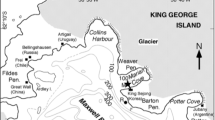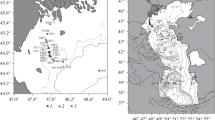Abstract
In the north-eastern part of the Black Sea, the seasonal complexes of dominant species of phytoplankton were fixed: small-celled diatom (spring), coccolithophores (late spring, early summer) and large diatoms (summer and autumn). In May–June 2005 and 2006, two invasive species of marine diatoms Chaetoceros throndsenii (maximal abundance 1.92 × 105 cells/l) and Chaetoceros minimus (1.6 × 105 cells/l) were recorded. These species have been incorporated in the complex of the late spring and early summer and grew simultaneously with the coccolithophore Emiliania huxleyi. The coccolithophore was dominant species, whose abundance had reached the level of a bloom. C. throndsenii was observed over the entire area from the coast to the centre of the sea; C. minimus were recorded at coastal stations and only at two stations of the open sea. Stratification of the water mass and the low (below the Redfield) ratio of nitrogen to phosphorus were observed at this time. Then, C. throndsenii was not marked even once, and C. minimus has been registered once on a shelf in June 2011. Experimental studies (2005) have shown that intensive growth C. throndsenii requires the simultaneous addition of nitrogen and phosphorus in a ratio close to the Redfield ratio. C. minimus shows the intensive growth only at high concentrations of phosphorus and at low nitrogen-to-phosphorus ratio (the experiment was carried out in June 2011). Mathematical modelling shows that C. throndsenii and Emiliania huxleyi form a stable couple whose growth is limited by different factors: the diatoms by nitrogen and the coccolithophores by phosphorus. C. minimus might not be able to form a stable couple with coccolithophores because they have the same limiting factor, i.e. phosphorus. However, this species could become the dominant one, if low (0.5–1) nitrogen-to-phosphorus ratio conditions were stable for more than 2 months. However, this scenario is improbable in natural circumstances since the existence of this complex seasonal rarely exceeds 1.5 months.






Similar content being viewed by others
References
Abrosov NS, Bogolyubov AG (1988) Ecological and genetic regularities of existence and co-evolution of species (Ekologicheskie i geneticheskie zakonomernosti sosushchestvovaniya i koevolyutsii vidov ). Nauka, Novosibirsk (in Russian)
AlgaeBase database. (http://www.algaebase.org). Accessed 20 May 2014
Bordovskiy OK, Chernyakova AM (eds) (1992) Modern methods of the ocean hydrochemical investigations. PP Shirshov Institute of Oceanology, Moscow (in Russian)
Brzezinski M (1985) The Si:C: N ratio of marine diatoms: interspecific variability and the effect of some environmental variables. J Phycol 21:347–357
Droop MR (1974) The nutrient status of algal cells in continuous culture. J Mar Biol Assoc UK 54:825–855
Genitsaris S, Moustaka-Gouni M, Kormas KA (2011) Airborne microeukaryote colonists in experimental water containers: diversity, succession, life histories and established food webs. Aquat Microb Ecol 62(Suppl.):139–152
Gomez F (2008) Phytoplankton invasions: comments on the validity of categorizing the non-indigenous dinoflagellates and diatoms in European Seas. Mar Pollut Bull 56:620–628
Grashoff K, Kremling K, Ehrhard M (1999) Methods of seawater analysis. Wiley, Weinheim
Hillebrand H, Durselen C, Kirschtel D, Pollingher U, Zohary T (1999) Biovolume calculation for pelagic and benthic microalgae. J Phycol 35:403–424
Kiselev IA (1969) Plankton of seas and continental basins (Plankton morey i continentalnyh vodoemov), vol 1. Nauka, Leningrad (in Russian)
Litchman E, Klausmeier CA, Bossard P (2004) Phytoplankton nutrient competition under dynamic light regimes. Limnol Oceanogr 49:1457–1462
Maksimov VN (1980) Multifactorial experiment in biology (Mnogofactornyi experiment v boilogii ). Nauka, Moscow, pp 164–190 (in Russian)
Marino D, Giuffé G, Montresor M, Zingone A (1991) An electron microscope investigation on Chaetoceros minimus (Levander) comb. nov. and new observations on Chaetoceros throndsenii (Marino, Montresor and Zingone) comb. nov. Diatom Res 6:317–326
Mehnert G, Leunert F, Cires S, Johnk KD, Erucker J, Nixdorf B, Wiedner C (2010) Competitiveness of invasive and native cyanobacteria from temperate freshwaters under various light and temperature conditions. J Plankton Res 32:1009–1021
Mikaelyan AS, Silkin VA, Pautova LA (2011) Coccolithophorids in the Black Sea: interannual and long-term changes. Oceanology 51:45–53
Moncheva S, Petrova-Karadjova V, Palasov A (1995) Harmful algal blooms along the Bulgarian Black Sea coast and possible patterns of fish and zoobenthic mortalities. In: Lassus P, Arzul G, Denn E, Gentien P (eds) Harmful marine algal blooms. Lavoisier Publ. Incorp, Paris, pp 193–198
Moncheva S, Gotsis-Skretas O, Pagou K, Krastev A (2001) Phytoplankton blooms in Black Sea and Mediterranean coastal ecosystems subjected to anthropogenic eutrophication: similarities and differences. Estuar Coast Shelf 53:281–295
Pakhomova S, Vinogradova E, Yakushev E, Zatsepin A, Shtereva G, Chasovnikov V, Podymov O (2014) Interannual variability of the Black Sea proper oxygen and nutrients regime: the role of climatic and anthropogenic forcing. Estuar Coast Shelf Sci 140:134–145
Parmesan C (2006) Ecological and evolutionary responses to recent climate change. Annu Rev Ecol Evol Syst 37:637–669
Pautova LA, Mikaelyan AS, Silkin VA (2007) The structure of the plankton community in shelf waters of the north-eastern part of the Black Sea in the period of mass bloom of Emiliania huxleyi in 2002–2005. Oceanology 47:408–417
Pautova LA, Silkin VA, Mikaelyan AS, Lukashova TA (2011) The growth of new species in the Black Sea: Chaetoceros throndsenii (Marino, Montresor & Zingone) Marino, Montresor & Zingone in natural and experimental conditions. Int J Algae 13:1–15
Pautova LA, Silkin VA, Lifanchuk AV (2013) New for the Black Sea species Chaetoceros minimus (Bacillariophyta): field observations and experimental studies. Int J Algae 15:121–134
Ryan WBF (2007) Status of the black sea flood hypothesis. In: Yanko-Hombach V, Gilbert AS, Panin N, Dolukhanov PM (eds) The Black Sea flood question: changes in coastline, climate and human settlement. Springer, Dordrecht, pp 63–88
Shevchenko OG, Orlova TY, Hernandez-Becerril DU (2006) The genus Chaetoceros (Bacillariophyta) from Peter the Great Bay, Sea of Japan. Bot Mar 4:236–258
Silkin VA, Khailov KM (1988) Bioecological mechanisms of aquaculture management. Nauka, Leningrad (in Russian)
Silkin VA, Pautova LA, Lifanchuk AV (2013) Physiological regulatory mechanisms of the marine phytoplankton community structure. Russ J Plant Physiol 60:541–548
Silkin VA, Pautova LA, Pakhomova SV, Lifanchuk AV, Yakushev EV, Chasovnikov VK (2014) Environmental control on phytoplankton community structure in the NE Black Sea. J Exp Marine Biol Ecol 461:267–274
The Black Sea Phytoplankton Check List. (http://www.phyto.bss.ibss.org.ua). Accessed 1 March 2014
Throndsen J, Hasle GR, Tangen K (2003) Norskkystplanktonflora. Almater Forlag AS, Oslo
Tilman D (1977) Resource competition between planktonic algae: an experimental and theoretical approach. Ecology 58:338–348
Tomas CR (ed) (1997) Identifying marine phytoplankton. Academic Press, San-Diego
Vinogradov ME, Sapojnikov VV, Shushkina EA (1992) Ecosystem of the Black Sea. Nauka, Moscow
Walther G, Roques A, Hulme PE, Sykes MT, Pysˇek P, Kuhn I, Zobel M, Bacher S, Botta-Dukat Z, Bugmann H, Czucz B, Dauber J, Hickler T, Jarosk V, Kenis M, Klotz S, Minchin D, Moora M, Nentwig W, Ott J, Panov VE, Reineking B, Robinet C, Semenchenko V, Solarz W, Thuiller W, Vila M, Vohland K, Settele J (2009) Alien species in a warmer world: risks and opportunities. Trends Ecol Evol 24:686–693
WoRMS (World Register of Marine Species). (http://www.marinespecies.org). Accessed 20 May 2014
Acknowledgments
This work was funded by the Russian Foundation for Basic Research (grants 16-05-00268).
Author information
Authors and Affiliations
Corresponding author
Additional information
Handling Editor: Bas Ibelings.
Rights and permissions
About this article
Cite this article
Silkin, V.A., Abakumov, A.I., Pautova, L.A. et al. Mechanisms of regulation of invasive processes in phytoplankton on the example of the north-eastern part of the Black Sea. Aquat Ecol 50, 221–234 (2016). https://doi.org/10.1007/s10452-016-9570-7
Received:
Accepted:
Published:
Issue Date:
DOI: https://doi.org/10.1007/s10452-016-9570-7




